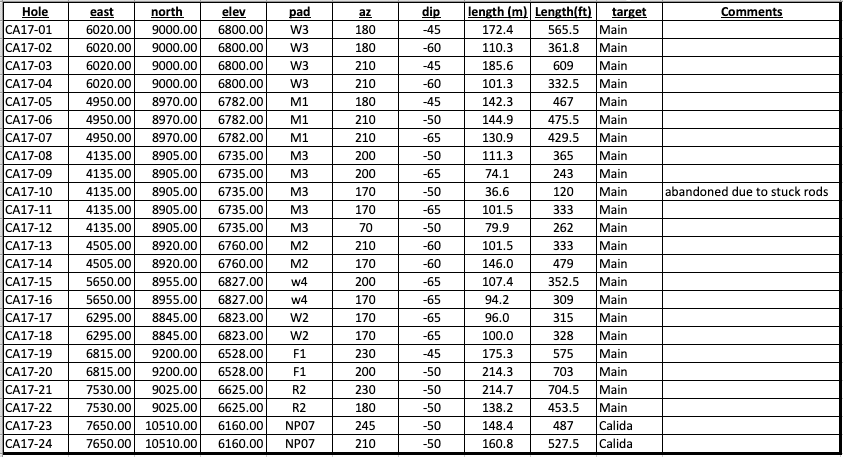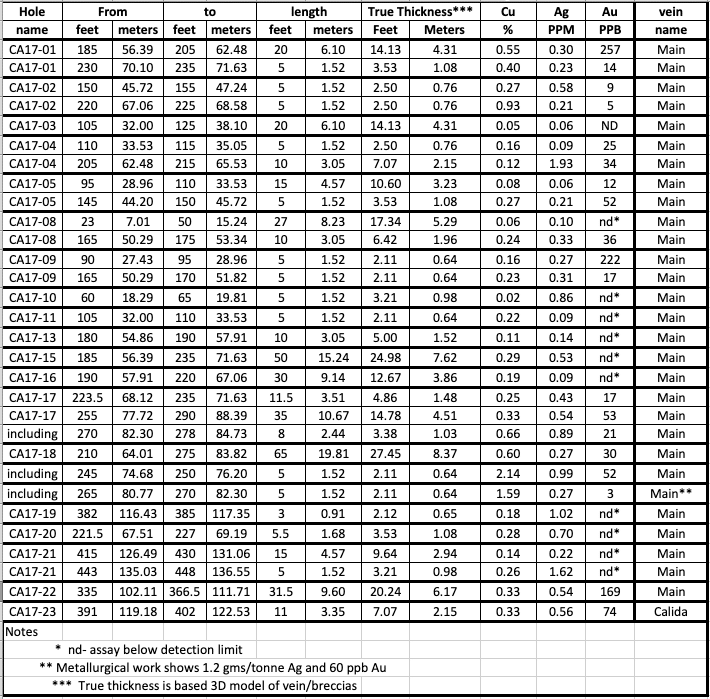American CuMo Mining Corporation (TSXV: MLY; OTC Pink: MLYCF) (“CuMoCo” or the “Company”) announces that as a result of a review by the British Columbia Securities Commission, the Company is issuing the following news release to clarify its previous disclosure.
As a result of the Company’s assay detailed verification program, it was discovered that there was high variability between individual assays, especially for silver. Also, several assays indicated no precious metals present within the sample where samples were within 20 feet of previous historical samples containing precious metals.
The detailed verification program is part of the overall quality assurance program the Company enacts as part of its assay procedures described below.
The entire core for the hole was sampled and cut in half using a diamond saw located in a Company secure facility. Half the core was sent for analysis and the other half has been kept and stored at the core facility located on site. Following cutting, the samples were delivered directly by Company personnel to ALS Chemex located in Elko, Nevada, a fully accredited independent analytical laboratory. They were first analyzed for 47 elements using a four (4) acid digestion with analysis by Inductively Coupled Argon Plasma Optical Mass Spectrometer (ICP-MS). Gold and silver are measured through a 50-gram sample using fire assay methods. Every 10th sample is re-analyzed including any samples considered to have significant values. In addition, duplicates, blanks, and standards were analyzed to ensure analytical accuracy and reproducibility. All rejects are being kept for further analysis and for use in metallurgical testing.
As a result of these discrepancies, upon completion of the drill program and the receipt of all assays, including checks and duplicates, the Company submitted seven core samples for microscopic analysis to Vancouver Petrographics Ltd of Langley, BC. The results of the analysis indicate two major points:
- Native silver was observed in samples that assayed low-grade silver
- A large portion (60 to 90%) of the copper-bearing sulphides were completely replaced by iron oxides.
The Vancouver Petrographics report has been placed on the Company’s website, including photographs of the samples. Click to view page.
The Company has determined that the assay variation was due to a “nugget effect” created by the irregular distribution of the precious metal grains in the samples, such that taking a standard 50-gm assay split from 8 to 15 kg samples was not representative of the precious metal (Au and Ag) contained in the sample. Also, it should be noted that the results revealed that this is a fine-grained effect, and therefore standard techniques, such as metallic assays, are not applicable.
Having established the presence of precious metals in the samples, the Company then submitted an entire sample from one of the better intersections to Process Mineralogical Consulting Ltd. of Maple Ridge, BC for detailed metallurgical analysis. The results from this sample indicated the presence of twelve (12) fine grains of native gold, ten (10) grains of Electrum, a naturally occurring alloy of gold and silver with trace amounts of copper and other metals, (average 75.4% gold, 24.6% silver, ranging from 61 to 93% gold) and four (4) grains of native silver. The observed gold grain size was below eight (8) microns, with the majority reporting to the minus 38-micron fraction. Twelve (12) % of the copper grade reported as sulphide. These results confirm the presence of precious metals within the system. The report is available on the Company’s website.
The head grade of the sample from the study was 1.2 ppm Ag and 60 ppb Au, which is higher than the assay grade for the sample of 0.27 ppm silver and 3 ppb gold.
Hole collar information is as follows and a plan can be found on the Company’s website.
The following table lists the grades of the intersections of the mineralized zones within the 2017 drill program:
List of Significant Intersections for the Calida Gold Drill Program
Currently, the Company cannot confirm the actual precious metal grade of the mineralized zones. The oxidation and subsequent destruction of minerals due to surface water penetration have significantly changed the original mineral composition. The Calida structures are extremely broken, which has not only led to penetration of the mineralizing fluids into the rocks but also extensive surface water penetration and subsequent destruction and leaching of a large portion of the metals contained within the upper parts of the structures. The 2017 drilling program was designed to examine the upper 350 feet of the 1.5-mile-long vein/breccia structures. The drilling intersected the structures as expected, and all intersections contained visible copper mineralization.
To get an accurate estimate of grades present at Calida Gold, additional drilling is required to find fresh, unaltered zones below the level of oxidization. The presence of the two forms of gold (native and Electrum) and native silver, together with copper, encourages continued work.
Mr. Shaun M. Dykes, M.Sc. (Eng), P.Geo., President and CEO of the Company, is the designated qualified person for the CuMo Project and the Calida Gold project and has prepared the technical information contained in this news release.
About CuMoCo
CuMoCo is focused on advancing its CuMo Project towards feasibility. CuMoCo is also advancing its Calida Gold project. Management is continuing to build an even stronger foundation from which to move the Company and its projects forward. For more information, please visit cumoco.com, idahocumo.com and cumoproject.com.
For further information, please contact:
American CuMo Mining Corporation
Shaun Dykes, President and Chief Executive Officer
Tel: (604) 689-7902
Email: info@cumoco.com
Neither the TSX Venture Exchange nor its Regulation Service Provider (as that term is defined in the policies of the TSX Venture Exchange) accepts responsibility for the adequacy or accuracy of this new release.
Cautionary statement regarding forward‐looking information
This news release contains “forward-looking information” within the meaning of applicable Canadian securities legislation including, but not limited to, statements that address activities, events or developments that the Company expects or anticipates will or may occur in the future. Often, but not always, forward-looking statements can be identified by the use of words such as “plans”, “expects”, “is expected”, “budgets”, “scheduled”, “estimates”, “forecasts”, “predicts”, “projects”, “intends”, “targets”, “aims”, “anticipates” or “believes” or variations (including negative variations) of such words and phrases or may be identified by statements to the effect that certain actions “may”, “could”, “should”, “would”, “might” or “will” be taken, occur or be achieved. Forward-looking statements and information include, but are not limited to, statements with respect to the transactions contemplated under the Private Placement, the completion of the Private Placement, Technical Report Environmental Studies and NSR Amendment and the revocation of the Cease Trade Order. Forward-looking statements and information are based on forecasts of future results, estimates of amounts not yet determinable and assumptions that, while believed by management to be reasonable, are inherently subject to significant business, economic and competitive uncertainties, and contingencies. Forward-looking statements and information are subject to various known and unknown risks and uncertainties, many of which are beyond the ability of the Company to control or predict, that may cause the Company’s actual results, performance or achievements to be materially different from those expressed or implied thereby, and are developed based on assumptions about such risks, uncertainties and other factors set out herein, including but not limited to: the requirement for regulatory or Exchange approvals or third-party consents, the impact of general business and economic conditions, and the absence of control over the completion of certain aspects of the Technical Report or Environmental Studies and the issuance of a full revocation of the Cease Trade Order. There can be no assurance that forward-looking information will prove to be accurate, as actual results and future events could differ materially from those anticipated in such statements. Accordingly, readers should not place undue reliance on forward-looking information. Except as required under applicable securities legislation, the Company undertakes no obligation to publicly update or revise forward-looking information.


